

| The Ultimate
Whizzers.
In 1899, the first car to exceed 100kph was the streamlined electric special of Camille Jenatzy (below), named La Jamais Contente - 'The Never Satisfied'. Summing up the attitude of all the LSR contenders ever since. 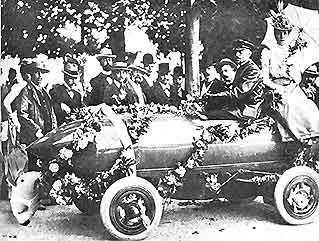
No web page can do full justice to this enormous and fascinating subject,
so all I shall attempt to do is give a flavour of it through some of my
favourite cars, their builders and drivers. A full list of all the official
Records is at the end of this article. Check out the book list at the bottom
for more information. Peter Renn..
The Bluebirds and the Golden Age.A successful racer at Brooklands, Captain Malcolm Campbell first started his association with the LSR by buying the 350hp Sunbeam which Kenelm Lee Guinness had used to set an new record of 133.75mph in 1922.In 1924 Campbell modified the car with a longer, streamlined tail and new fairings to the body and suspension. The car was repainted in Campbell's favourite shade of blue and named "Bluebird" the same as his pre-war racing cars. After a couple of abortive attempts at Fanöe beach in Denmark, where tyre failures caused the death of one boy spectator and nearly destroyed the car, Campbell moved to Pendine Sands in South Wales and raised the record twice to 146.16 and then 150.76mph. Campbell realised that the Sunbeam with its elderly 18 litre Manitou aircraft engine was not going to stay competitive for long, and had ambitious plans for an all new 'Bluebird'. The new car took two years to build at enormous cost. Using a 450hp 12 cylinder Napier Lion aero engine, a huge Chassis built by Vickers Ltd. and a body made by Jarvis & Sons of Wimbledon, the machine was built by the Robin Hood Engineering Works in Putney Vale. 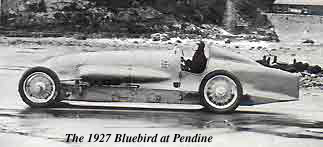
In 1927, by now obsessed with the record which had been pushed up to 171.02mph by Parry Thomas's Babs during his absence, Campbell rushed the new car to Pendine and without waiting for favourable weather or tide conditions set out on the soaking, soft beach. He managed a time through the flying kilometre at 179.158mph and was running even faster on his return run when he hit a sharp bump in the sand which knocked his goggles off. Driving one handed at nearly three miles a minute on streaming wet sand, he managed to replace them and regained enough speed to regain the record at an average of 174.883mph. The horrific death of Parry Thomas in 1927 was the end for Pendine Sands
as a record course. Major Henry Seagrave used Daytona beach and raised
the record in a quantum leap to over 200mph in his 1000 horsepower Sunbeam.
This huge increase meant that Campbell had to redesign
Bluebird
again, using a high boost version of the Lion Engine prepared for the Schneider
Trophy air race developing 875hp and a completely new wind tunnel tested
body designed for it by Vickers. The Car was ready by the start of 1928.
Moving the course to Daytona had renewed American interest in the LSR
and a number of projects were under way to try to end the British car's
domination.. Frank Lockhart was killed when his beautiful and fast
Black Hawk Stutz burst a tyre at nearly 220mph Campbell gave up on Veneuk Pan and returned to give Bluebird her biggest
redesign yet. The car was reduced to its bare chassis and under the auspices
of Reid Railton at Thompson and Taylor of Booklands a new 1450 bhp Napier
engine, K.L.G. gearbox and offset propshaft. The body was again redesigned
much lower with a large stabilising fin at the rear.
In 1933, the Napier engine was replaced by a 36.5 litre Rolls Royce R type unit giving 2300 hp. With this and some minor modifications to the bodywork Campbell raised his own record to a huge 272.46mph. Despite the lack of challengers to his record, he wouldn't rest on his laurels and determined to be the first to 300mph. Yet another version of Bluebird was prepared with an all enclosing body, twin rear wheels and vacuum operated air brakes. The Car achieved a new LSR of 276.816mph but it was clear Daytona was now becoming too short at 10 miles to give enough room for these high speeds and the soft surface caused wheelspin problems. Various record cars including the enormous pre-war Blitzen Benz
and John Cobb's Napier Railton had used the dry lake Bonneville
as a surface. This enormous area of salt flats was chosen as the venue
for the assault on the 'Three Hundred'. In September 1935 a course
was laid out on the salt and the Bluebird set out early in the morning
of September 3rd .Oil covered the windscreen as he entered the measured
mile and a front tyre burst towards the end of the run but Campbell held
the car and stopped safely albeit with three tyres shredded to the canvas
and one on fire. As the car was prepared for the return run, Campbell's
son Donald tried to talk to him but quickly realised that it was the wrong
thing to do, as the obsessive record breaker was quite expecting to die
on the second run. Again the tyres were shredded and the car went into
a lurid slide at the end of the course but stopped safely. The average
for the two runs was 301.129mph. Finally the indefatigable Campbell was
satisfied, at least with the LSR. He turned his attention then to the water
speed record, still making and planning speed records until his death at
63 in 1948.
The Wheel Driven RecordSir Malcolm Campbell had firmly established record breaking in the public imagination. By the time Bluebird had achieved 300mph in 1935 the major players were all household names in England. Captain George Eyston's Thunderbolt record car, a 73 litre, twin Rolls Royce engined monster raised the target to 312.00mph in 1937, starting a duel with the quiet, modest Surrey fur broker John Cobb, whose exploits in the 23 litre Napier Railton at Brooklands and Bonneville were well known. Cobb held the highest regard for Reid Railton's design genius, and this together with his own almost shy modesty led to the naming of his new LSR car simply as the Railton.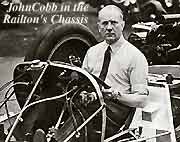
Startlingly beautiful in its purity, the shape of the Railton was an almost perfect teardrop. The one-piece shell lifted off to reveal an S shaped chassis containing two Napier Lion Engines which drove all four wheels. Built by Thompson and Taylor, the Railton was ready for a record attempt in the summer of 1938, arriving at Bonneville at the same time as Eyston's new Thunderbolt. The Thunderbolt pushed its own record up to 345.49mph before the much smaller engined Railton was the first to 350mph a few weeks later. 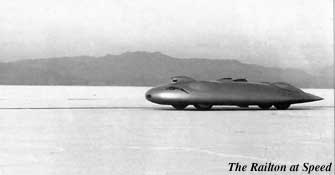
Cobb's record was only to stand for one day however, as Eyston took his quickly modified behemoth out the next morning and raised the record to 357.50mph. The following year, on the eve of the second World War Cobb returned to Bonneville and flashed through the measured mile in less than ten seconds to set a new figure of 369.70mph. The war precluded any more record attempts (including the very interesting stillborn T80 Daimler Benz project now resting in the Mercedes museum in Stuttgart) so it wasn't until 1947 that Cobb returned, His sights firmly set on 400mph in 1947. Bonneville's salt floods each winter so the surface varies according to the weather. This year it was bumpier than usual with soft patches and pot holes so while the Railton touched 403, the average for the two runs (and a new record) was a tantalising 394.196mph. For sixteen years, Cobb's record stood and, like the four minute mile,
the four hundred miles per hour record seemed unattainable. "Class records"
for cars of specific engine size or over longer distances were broken but
despite the efforts of LSR legends such as Art Arfons, Mickey Thompson
and Dr. Nathan Ostich no one came very close to the Railton's record.
Don Vesco's turbine powered (but wheel driven) streamliner has recently (October 2001) raised the official FIA wheel driven record to458.440 mph! A fantastic achievement. He said " The down run Thursday morning at 11:03 a.m. resulted in a speed over the measured mile of 458.718 MPH. The return run at 11:58 a.m. was 458.162 MPH for an average of 458.440 MPH. The weather that morning was perfect, about 60 degrees (f), very little wind, no clouds. The salt was the best I have seen it in the 43 years I have been going to Bonneville." Pictures and more info are set to appear on the Team Vesco site at www.teamvesco.com Stop Press...December 16 2002. I'm very
sorry to report that Don Vesco has died, of cancer in San Diego aged 63.
One of the great names of record breaking and a Bonneville legend. He will
be greatly missed.
Jet ThrustCraig Breedlove is to the jet car age as Sir Malcolm Campbell was to the 'twenties and 'thirties. The first to break 400, 500 and 600mph, he was finally eclipsed by The Blue Flame of Gary Gabelich 1n 1970 which raised the record to 622.407mph. There it stood for thirteen years while the world economic climate and a loss of public interest in record breaking seemed to mean that no serious challenge would emerge.The patriotic British businessman Richard Noble however was busy working towards a record attempt. After spending almost every penny he had on Thrust 1, a fairly crude device used as a rolling test bed he destroyed it in a 140mph roll at RAF Fairford in 1977. Undaunted, the same evening he began work on Thrust 2. Thrust 2 was a proper LSR car, with a tubular spaceframe chassis housing a Rolls Royce Avon turbojet from a Lightning fighter. The basic design being loosely based on one of Art Arfons' Green Monster cars. The whole car was built on an incredibly tight budget. For example, the donation by Lucas of a switch and a few feet of cable qualified them as a major sponsor! By taking a stand at the 1977 London Motorfair Noble and his team managed to enthuse the public and persuade reluctant captains of industry to help. Eventually, after innumerable financial and technical crises the Car was shipped to Bonneville in 1981 where Noble managed a peak speed of 500mph before the rains came ant turned the course back into a lake. This was similar to the appalling bad luck suffered by both Malcolm and Donald Campbell, especially when they were flooded out the following year without turning a wheel, but they had at least proved the car had potential. In 1983, moving to the Black rock Desert in Nevada, The Thrust 2 team set a new LSR of 633.468mph as Richard Noble said "For Britain, and the Hell of it" 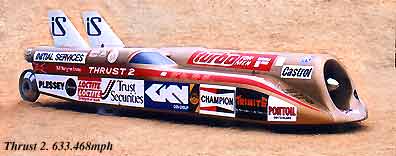
Although they had only broken Gabelich's record by a small margin, no serious contenders seemed inspired to take Thrust 2's LSR crown, Until in the early 'nineties a number of projects were rumoured. Australian Rosco McGlashan was building a Thrust 2 lookalike called Aussie Invader II, There were stories that the Maclaren F1 team were working on a LSR vehicle and that Craig Breedlove was planning a new Spirit of America. Noble had wanted to build another car for some time and realised that the last great prize was the speed of sound. He had taught himself to drive Thrust 2 despite having no experience of racing or speed testing and acquitted himself brilliantly but he appreciated that controlling something with more than twice the power through the sound barrier was a job for an expert! Flight Lieutenant Andy Green was selected from a field of applicants including pilots, race and rally drivers as the man with the 'right stuff'. His experience in flying supersonic fighters for the RAF and almost superhuman coolness under pressure made him the obvious choice. The Aussie Invader and Maclaren projects evaporated but Breedlove's
Spirit
of America was built. This astonishing vehicle, said to owe more to
eye judgement than computer modelling was actually ready at the same time
as Thrust SSC and both camps were on the Black Rock Desert together.
Sadly Breedlove missed out on being the first to 700mph and he survived
a huge scare when the Spirit suddenly veered nearly ninety degrees
off course. In the true spirit of record breaking, the gentlemanly Breedlove
offered the Thrust team the use of all his facilities and stayed on with
his damaged car to help and cheer them on. The official list of Land Speed Record holders is below. All speeds are in miles per hour. British Contenders in Green, American in white, others in blue. Some early records were not recognised by European authorities at the time. The exact rules have changed a little over the years but the basic ones are that the car has to make two timed runs in opposite directions over a measured mile within one hour. Note: If you are wondering about the Budweiser Rocket car of Stan Barrett which claimed to have broken the sound barrier in the 'seventies this is a highly controversial project! It is debatable, unlikely or downright impossible (depending on your point of view) whether this car reached anything like the speed of sound. The project team basically wrote their own rules and claimed a speed which no one outside the team could verify. It therefore holds no official record despite the claims made for it. For more on this visit hhtp://roadsters.com/ or read Robin Richardson's article "The Great Pretender" at http://nitronic.com/research11/great.html - P.R. This page has concentrated exclusively on the outright LSR as the jewel in the crown of speed. The wheel driven record is now the province of men like Don Vesco and Al Teague, both of whom run wheel driven streamliners at over 400mph. Things start to get complicated here as Vesco's "Turbinator" runs a turbine while the Teague "Spirit of 76" has a piston engine, so both claim records in different classes. NB: Mr. Vesco has recently made an FIA sanctioned pair of runs averaging 458.440 mph. The American 'land speed racers' often seem to resent the FIA as the official governing body for international record attempts, pointing out that organisations like the SCTA who run Bonneville Speed Week etc. have over 50 years of experience in timing record attempts and could do the job as well if not better than expensive European officials. The counter to this is however, that the FIA is the world governing body of motorsport and only its sanction gives a record solid gold credibility. Don Vesco is one who recognises this and his insistence on having world officials present for his record runs has paid off. He is now unarguably the fastest wheel driven man on earth by along, long way. To find out more try some of these. Most are out of print now but turn
up at autojumble bookstalls fairly regularly.
Bluebird and the Dead Lake John Pearson Collins 1965 Land Speed Record Cyril Posthumous & David Tremayne Osprey 1985 (1971) Man Against the Salt Harvey Shapiro Minerva 1997 The Fastest Man on Earth David Tremayne 633 Club 1986 BP Book of the Racing Campbells Richard Hough Stanley Paul 1960 The Record Breakers Leo Villa Hamlyn 1969 Leap into Legend Steve Holter Sigma 2002 Thrust. Through the Sound Barrier Richard Noble Transworld Publishers
Ltd. 1998
This page is designed to be a brief outline history of the Land Speed Record, with some useful links for those who wish to find out more. There are a lot of excellent sites out there, written by people with much greater knowledge than mine. I particularly recommend The Thrust SSC web site: http://www.thrustssc.com/thrustssc/History/history.html as a source of historical data and news of current projects from around the world. Where to find the cars: The KLG Sunbeam, 1000hp Sunbeam, Golden Arrow and CN7 Bluebird are all at the National Motor Museum at Beaulieu in Hampshire The Napier-Railton long distance record car, plus lots of Bluebird/ Campbell memorabilia and LSR display s are at Brooklands Museum in Weybridge. The Railton Mobil Special is at Birmingham's Museum of Science and Industry (now part of Millenium Point). http://www.millenniumpoint.org.uk The 1935 Bluebird is newly restored and on display at the Daytona International Speedway Circuit, Florida USA: Replicas of various Bluebird cars and boats are part of a large display at the Lakeland Motor Museum. Nathan Ostich's Jet car, the Flying Caduceus is in the William F Harrah National Automobile Museum, 10 Lake Street South, Reno, Nevada USA. Thrust SSC and Thrust 2 are on display at The Museum of British Road Transport in Coventry. Lastly of course, go to Bonneville Speed Week! See the feature
article on this site . Also visit the organisers, the Southern
California Timing Association.
HOME EVENTSGARAGE L.S.R. GALLERY FEATURES SPARES LINKS CONTACT |